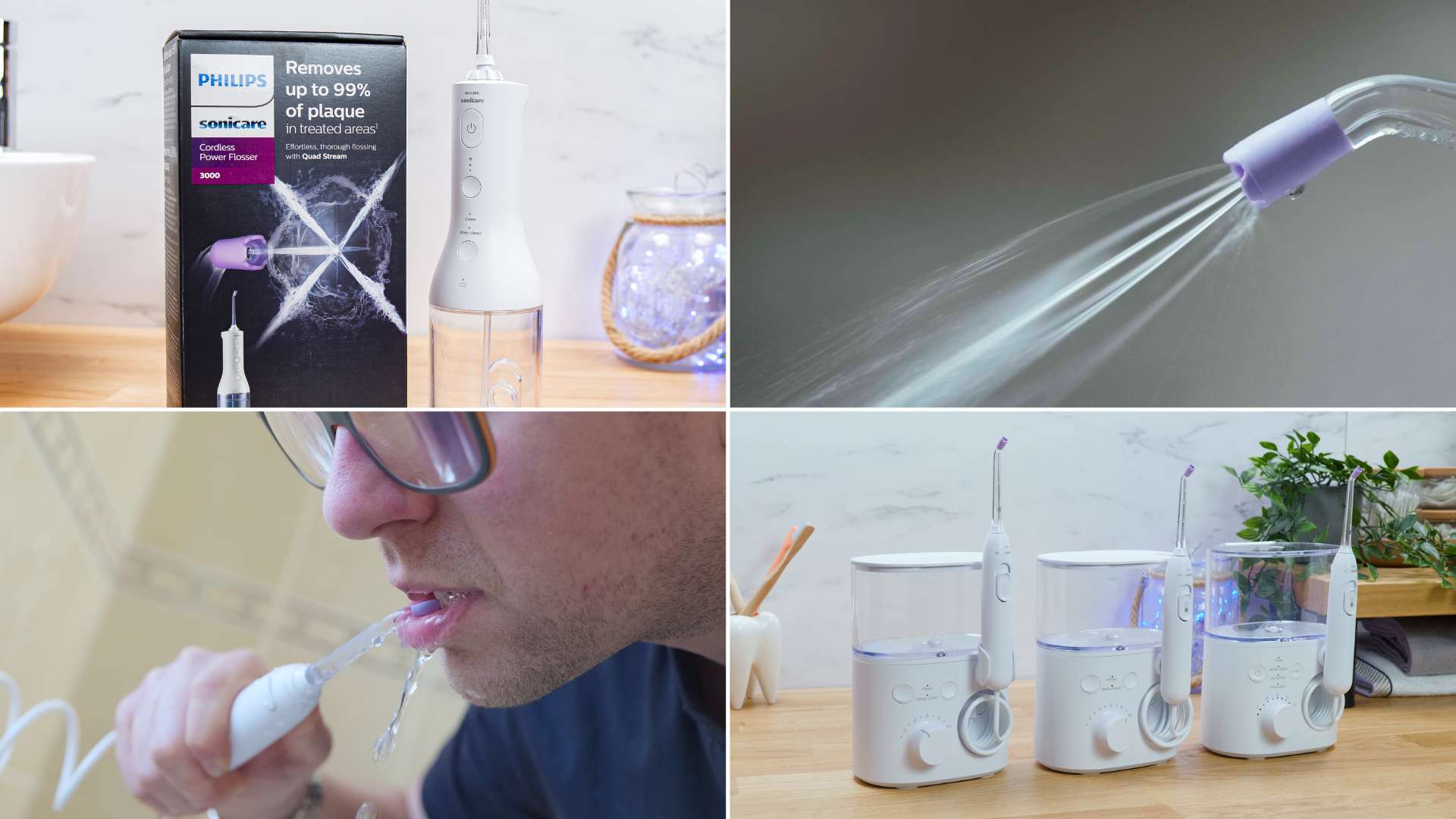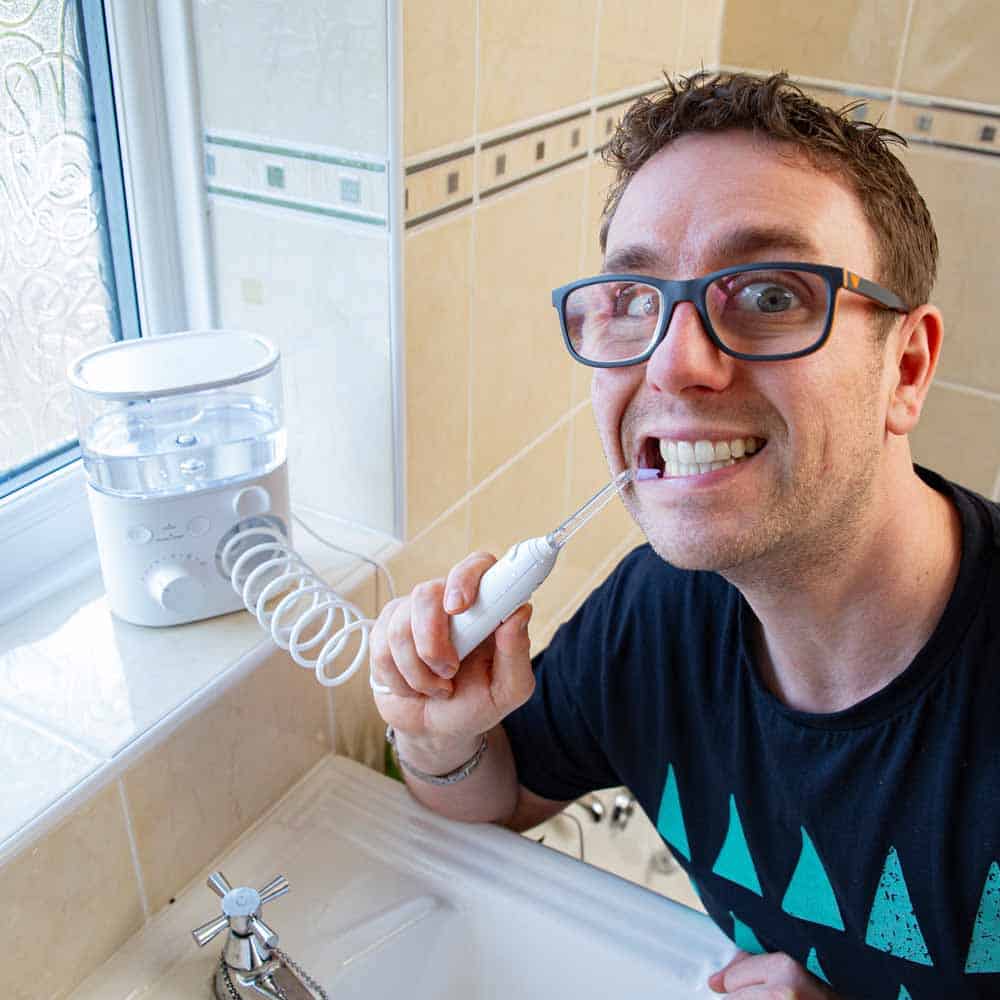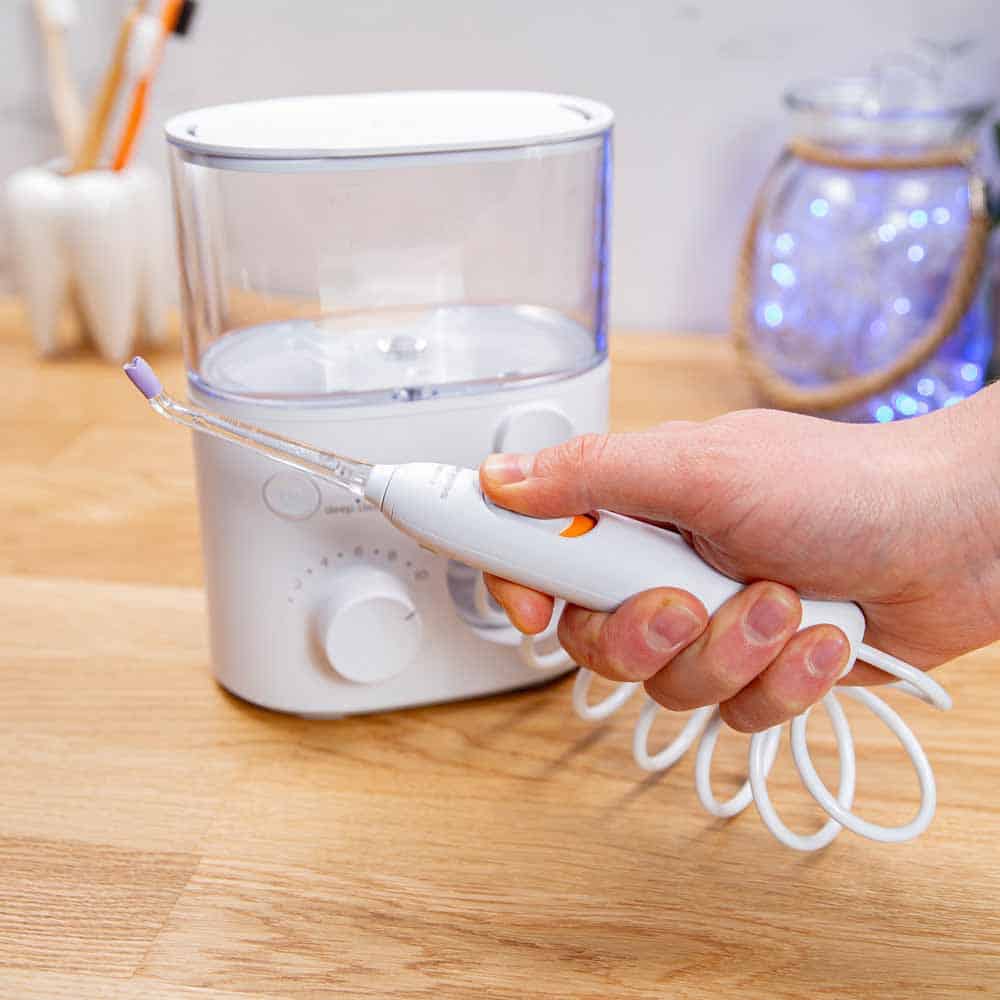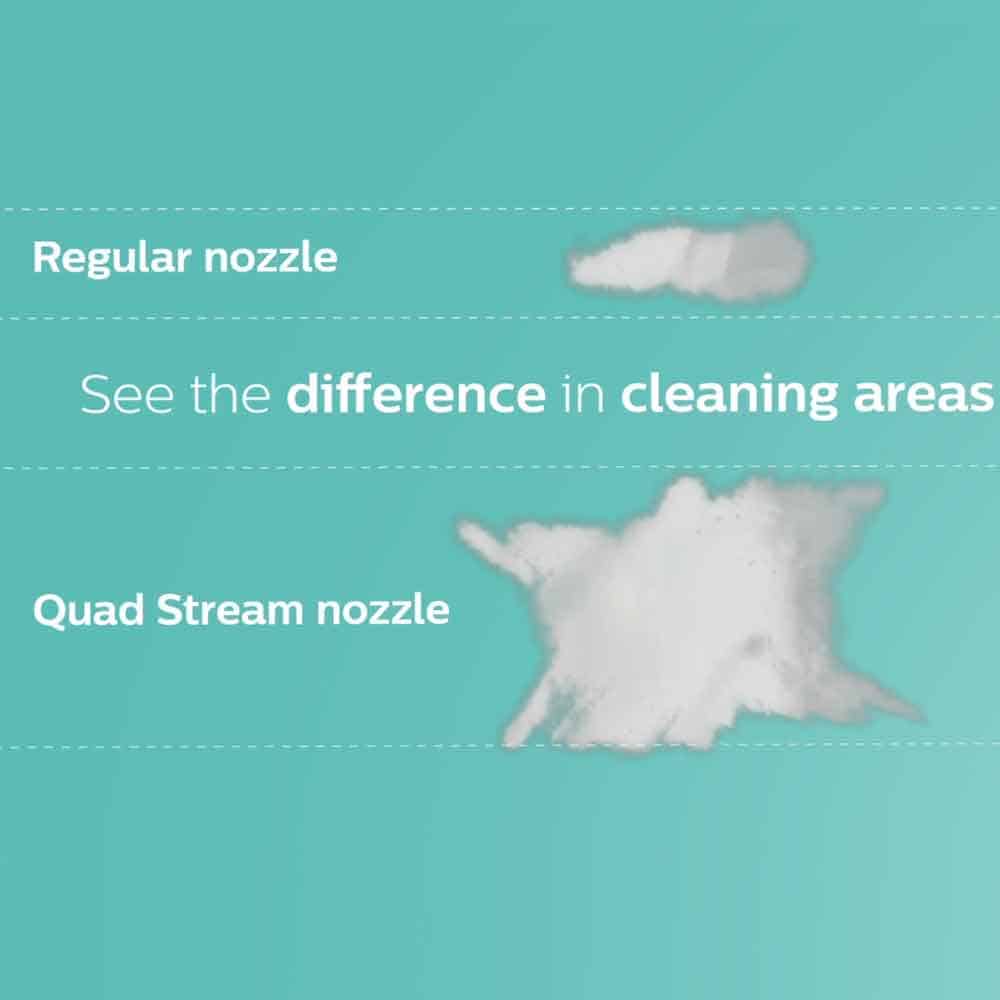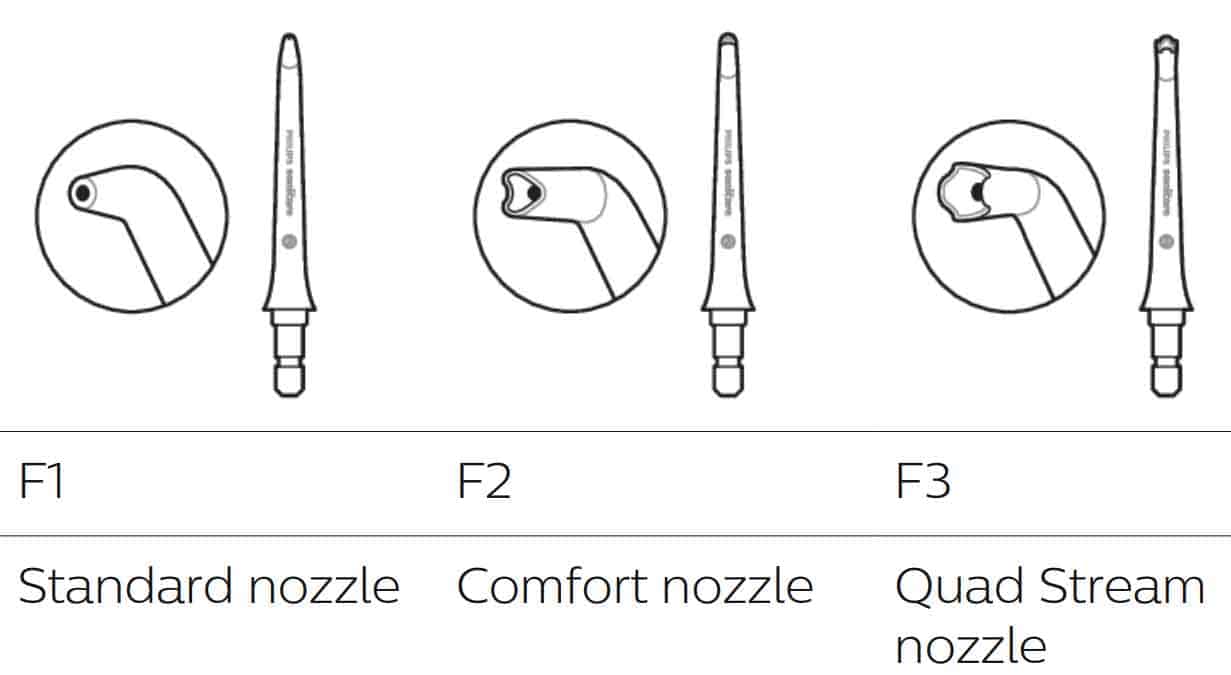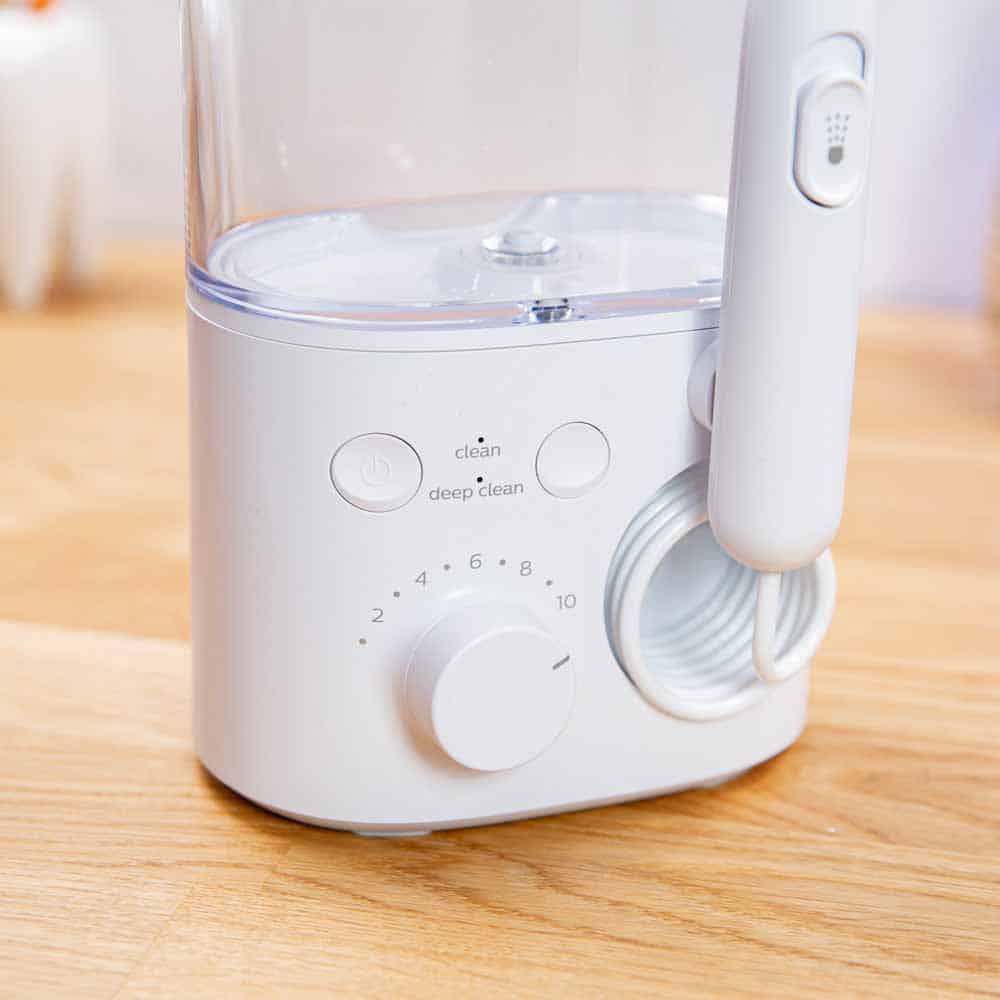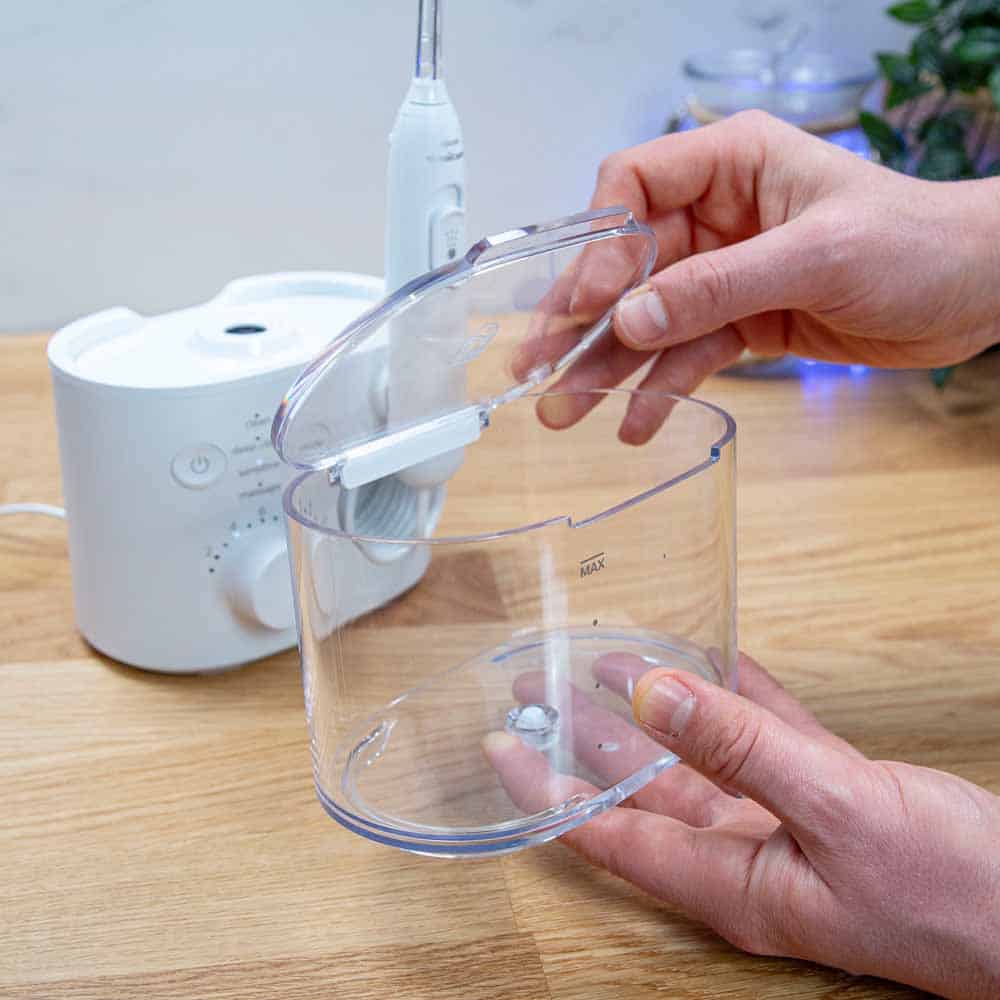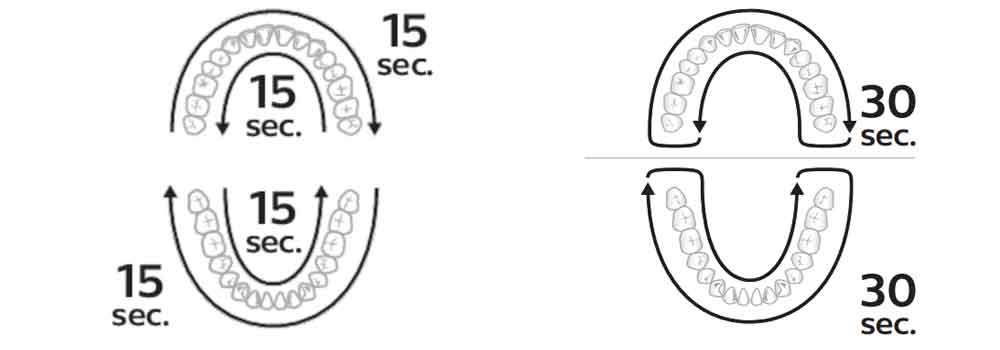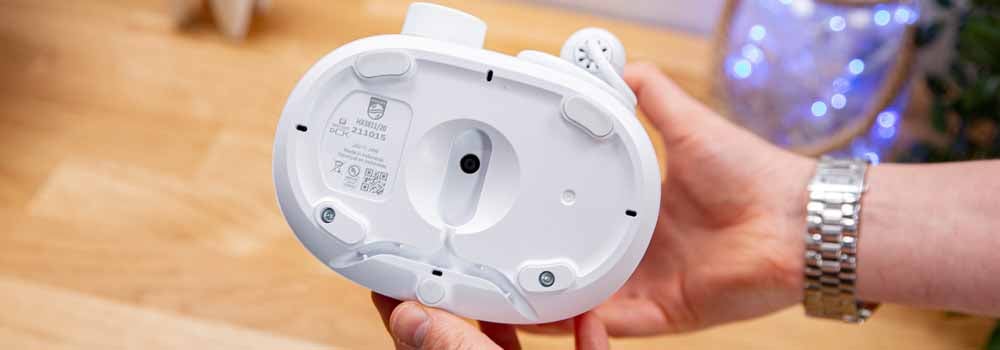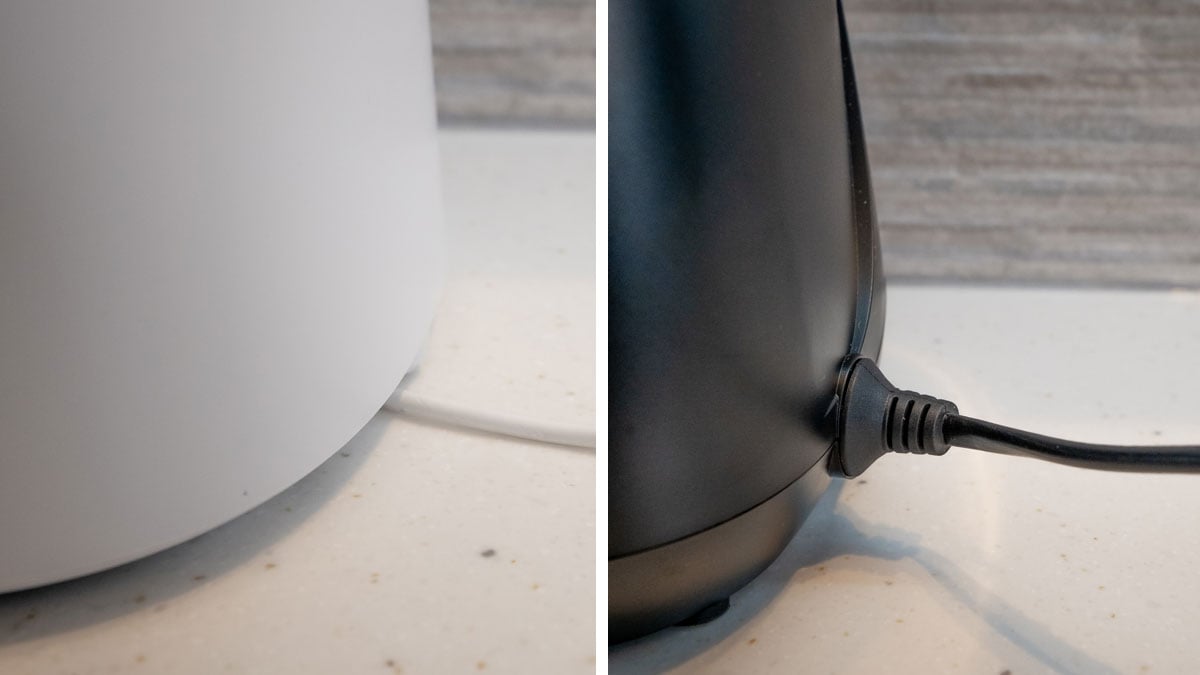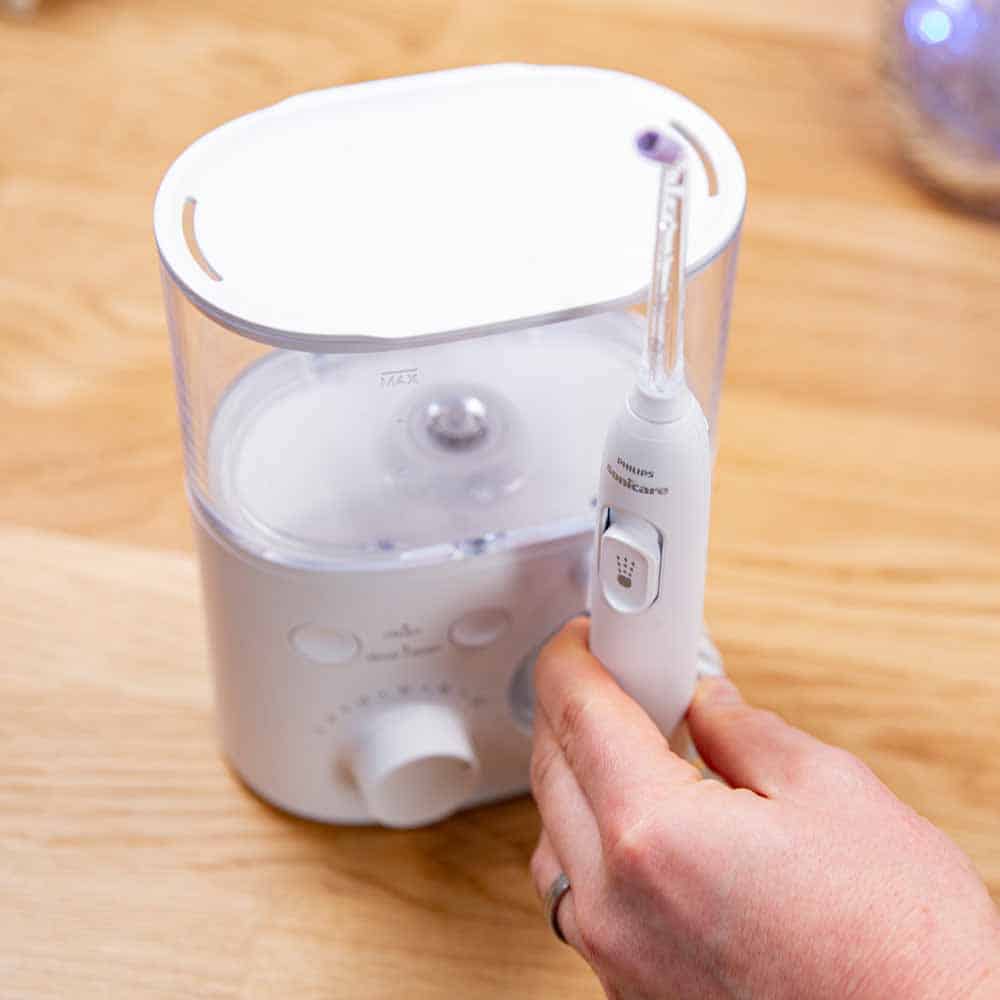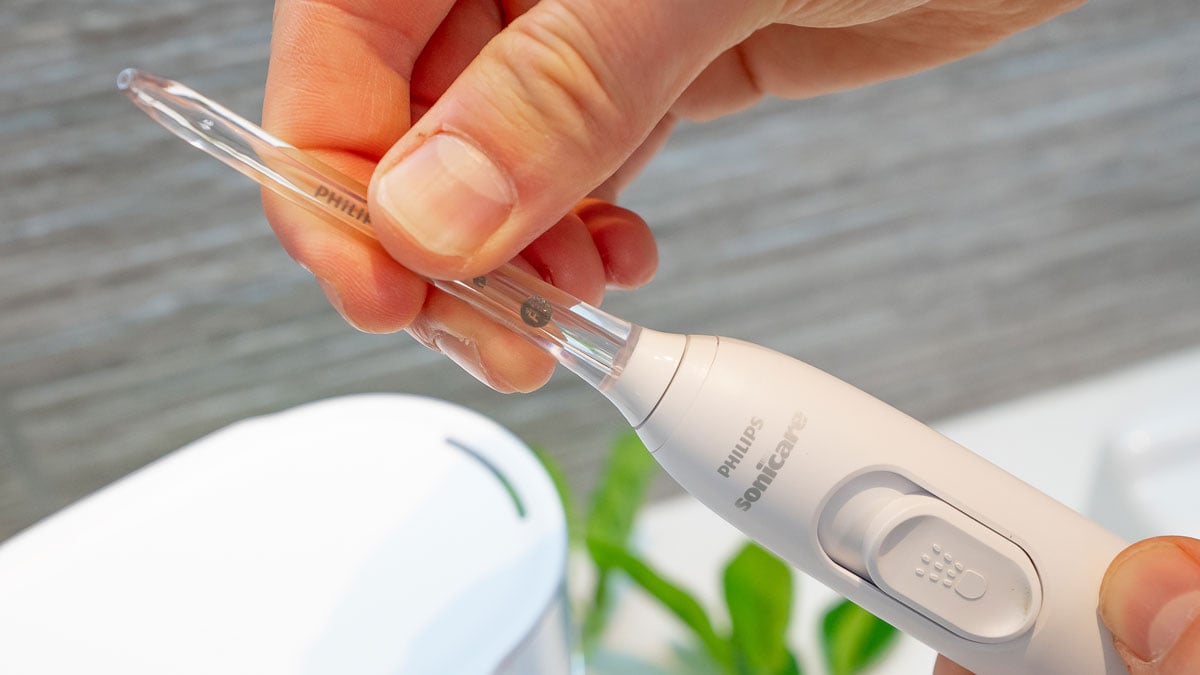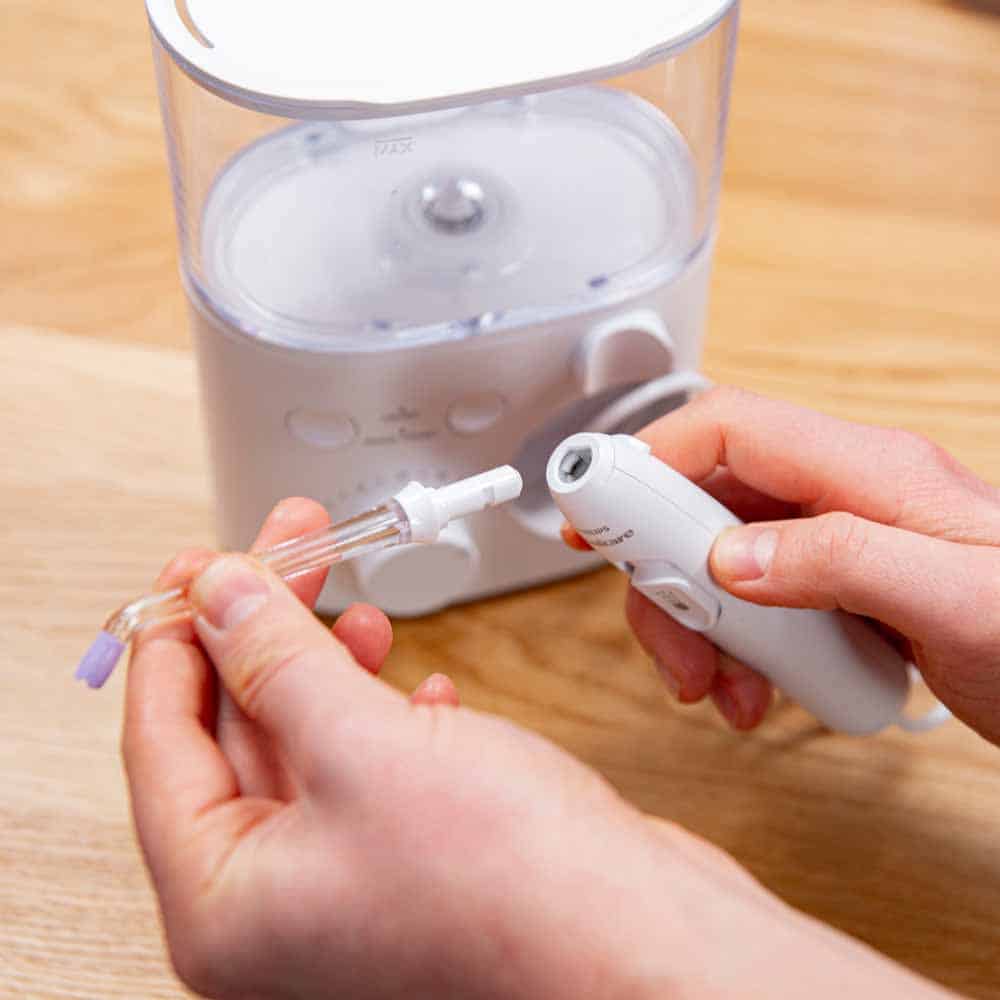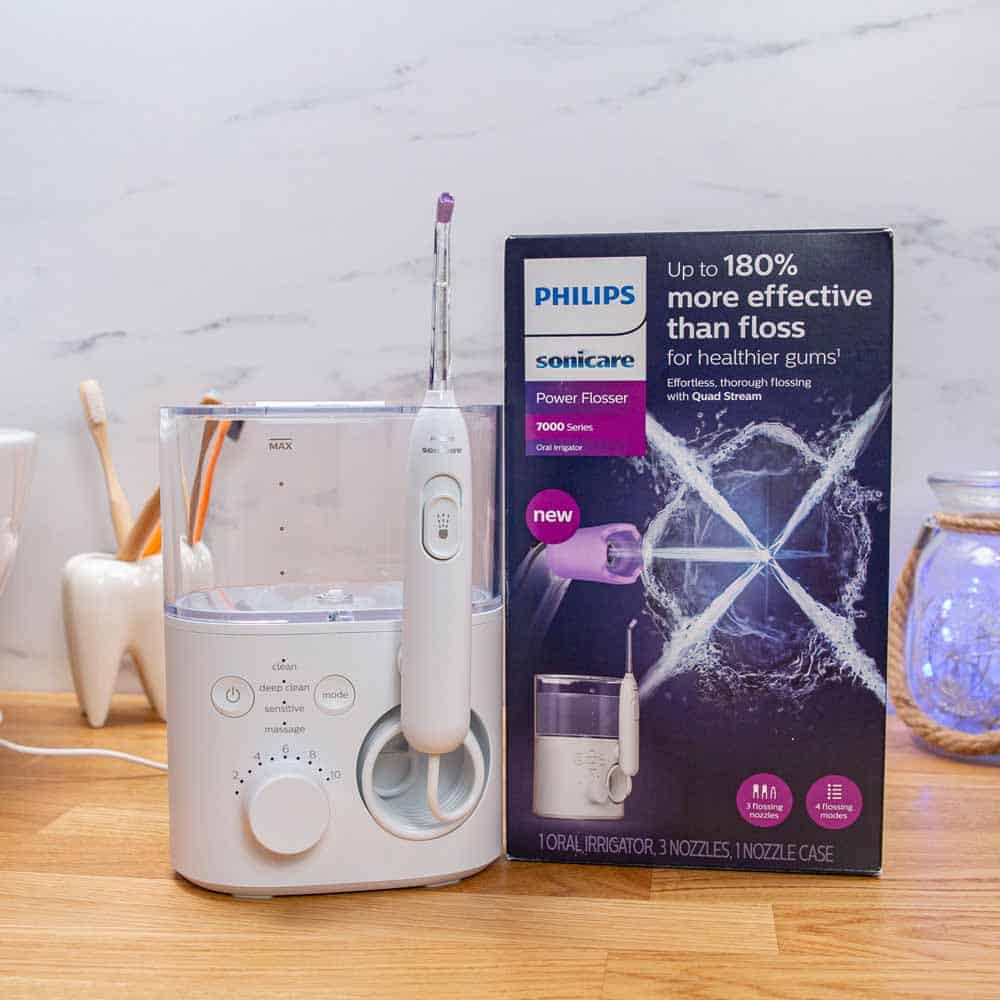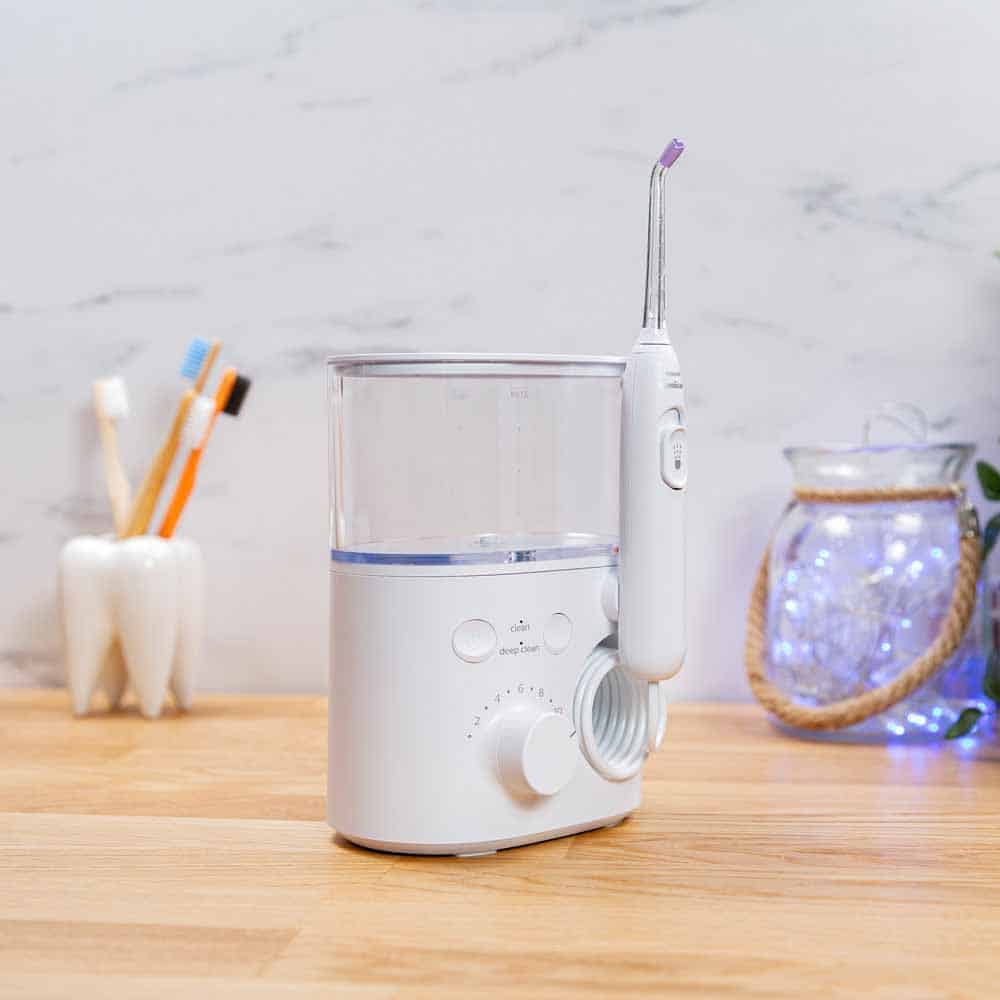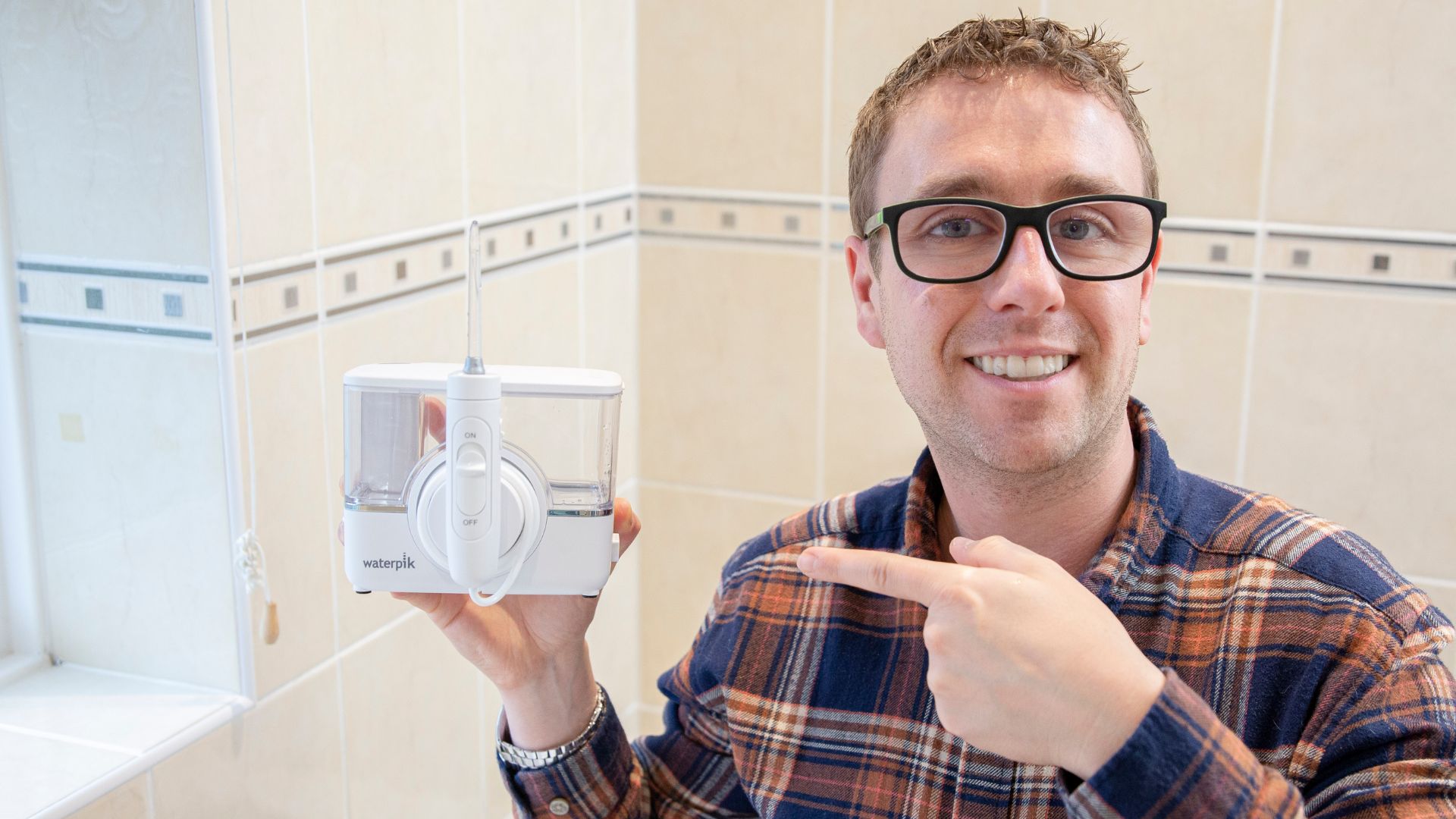
The first countertop with rechargeable battery
With a built-in rechargeable battery, the ION is an incredibly versatile solution.
It has all the good things of a market leading water flosser, including great cleaning results.
But, whilst more compact it is perhaps a little too big to be a real travel friendly option like other cordless options.

Pros |
Cons |
|---|---|

Rotating handle & nozzle for easier control |
Nozzle rotation is more difficult |

Compact & stylish size reduces footprint |
The smaller handle is slightly more tricky to hold |

Timer built-in to encourage even flossing |
Compact but not so travel friendly |

American Dental Association (ADA) approved |
Consider these other flossers
The Waterpik Aquarius is my top choice if you want a countertop water flosser.
With a built-in rechargeable battery, the ION is a bit different and truthfully isn’t really far behind in features and performance.
What you ultimately want from a water flosser will have a big part to play, but if being wire free is what you desire, then the Cordless Advanced is a solid alternative choice.
Or Waterpik's Sidekick is somewhere in between. Countertop esq setup in a compact form factor.

Design, usability, clean & general use
Before I dig into all the details about the ION and what it is really like to use, I want to quickly explain exactly what it is.
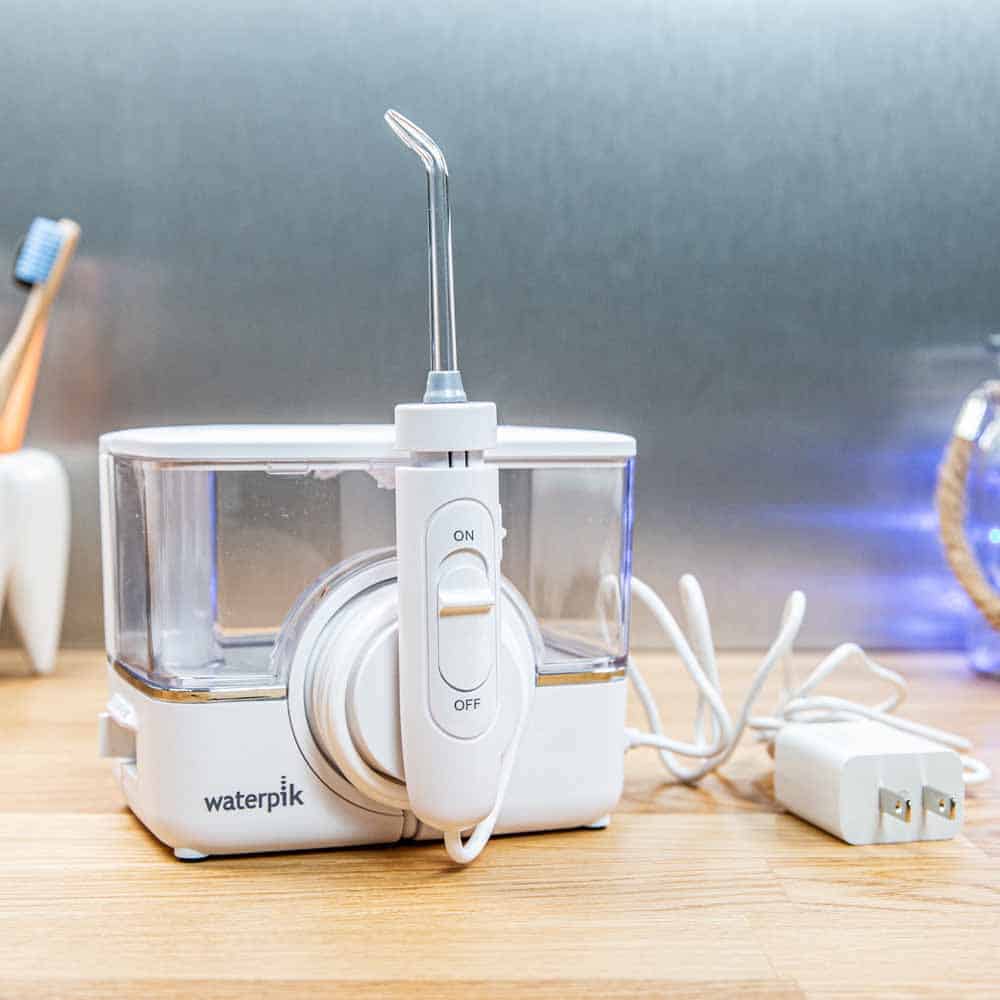
Typically, water flossers are either corded or cordless.
Corded units are also commonly referred to as countertop units.
As the name implies, the cordless models give you more freedom and less restriction as they need not be connected to a mains power supply. The power supply in cordless models are batteries, be those AA or rechargeable options inside the unit.
By design they are more compact and the option most would take with them if they want a water flosser as they travel.
Although there are always models that break the rules, more often than not countertop units are more versatile. They have more features due to their increased size. The 2 biggest benefits tend to be the larger water tanks, offering longer flossing times and the greater variety of pressure settings.
You wouldn’t normally take a countertop water flosser with you when you travel. The exception being the Waterpik WF-04 Sidekick which is designed to be portable, but has to be plugged in to function.
The ION is a bit of a cross between the 2 product categories, although technically it falls under the cordless options as it has a rechargeable battery inside it.
The ION has the benefits of a regular countertop unit, whilst also being some 30% smaller in size.
It is more compact so you could travel with it, but it is still quite bulky and doesn’t come with the likes of a travel case. So, although cordless, it isn’t really designed for travel.
And although cordless it has a handle and long hose that most don’t have. The main unit needs to sit on the countertop.
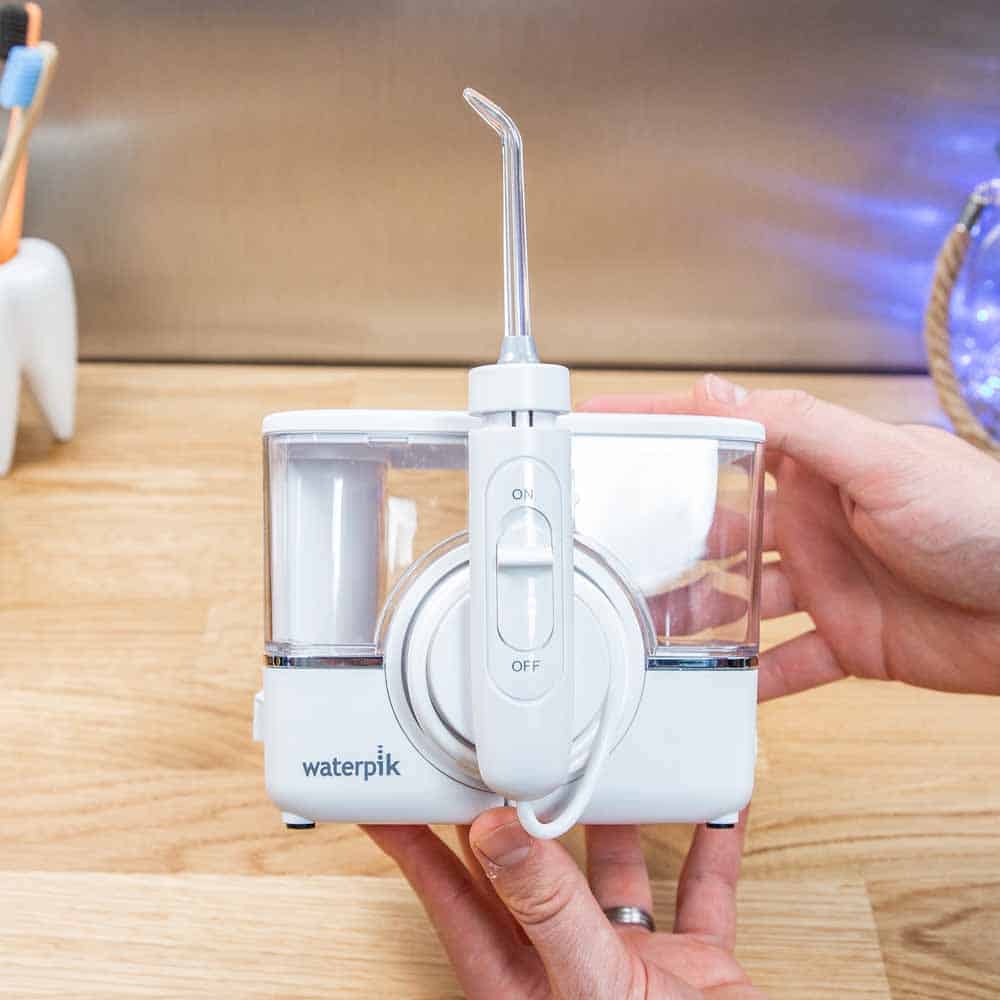
Although potentially anyone can benefit from it, the users this appeals most to are those that don’t have a power outlet in their bathroom. That includes myself.
Or it could suit families where it gets moved from 1 bathroom to another, without the need to take the power adapter.
Basically, the ION is a bit different and fills a gap in the market that few others do.
If you are new to the concept of water flossing, allow me to explain briefly what it is.
It isn’t a new thing, it has been around for years. But, it isn’t something that is all that heavily promoted by dental professionals.
It is an alternative tool that you can use to clean in between the teeth and along the gumline.
Where you might normally have used floss, you can use a water flosser.
It is technique sensitive, like flossing, but it is generally a bit more convenient and as such becomes a habit you are more likely to stick to.
Waterpik has plenty of clinical evidence to prove that their products are more effective than string floss, but many dental professionals still recommend regular string floss because it makes a physical contact with the teeth that water flossing doesn’t.
But, if you really struggle to form a flossing habit, then water flossing is a very solid option. It is likely one that your dental professional would rather you do, than to not floss at all.
Only 37.5% of Americans floss daily. Why don’t the other 60%? Probably because they find flossing tricky or frustrating etc. This is where water flossing takes away some of these issues.
There are pros and cons to each and I am not here to suggest which is right. The American Dental Association (ADA) feel that Waterpiks water flossers are good enough, because they have awarded it their seal of acceptance.
To achieve such the products have to undergo independent testing and claims made have to be verified and proven to be accurate. Such certification brings peace of mind to you and me as users.
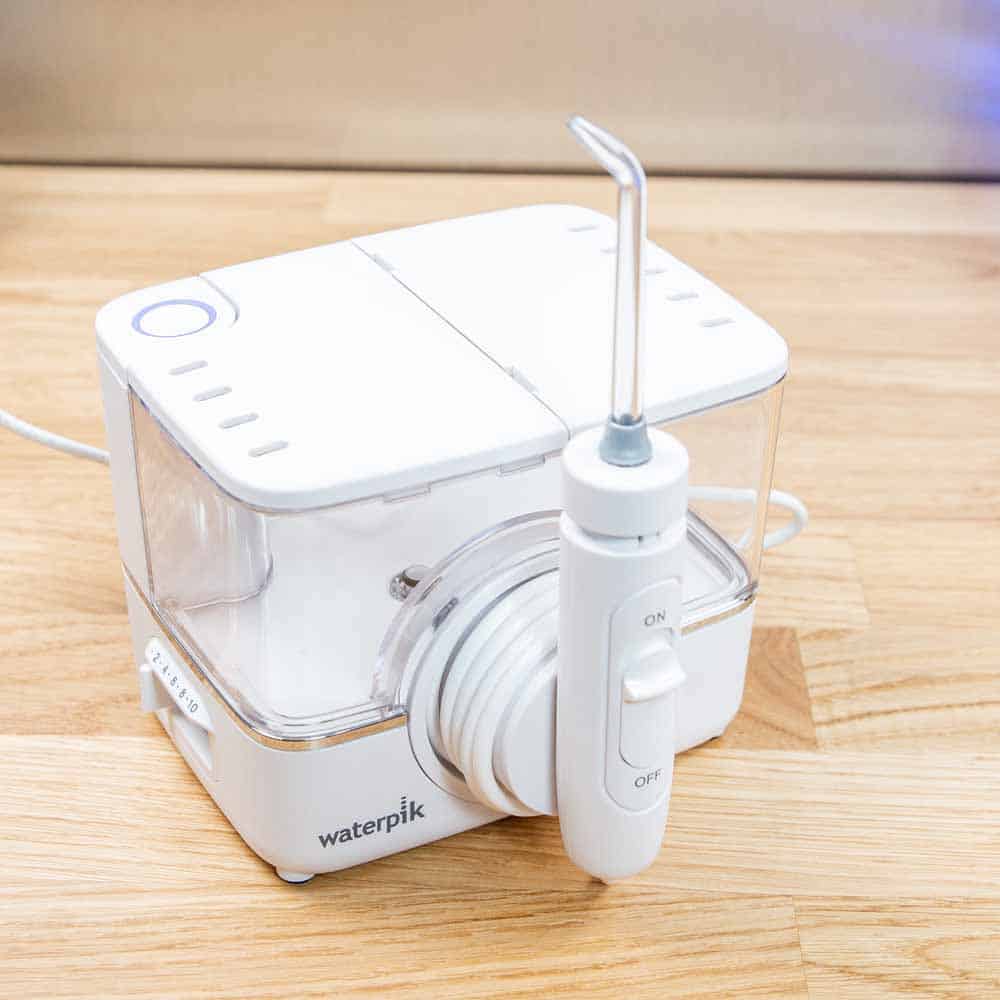
Another big thing to mention I feel is how messy water flossing can be. This applies to all water flossers, irrespective of brand and whether it is a countertop or cordless option.
You have to be lent over a sink really. This is because the volume of water pushed into the mouth during use essentially forces you to expel it somewhere. It will dribble down your chin, this is normal.
It takes practice to master the technique. Even experienced users will slip up at times and you will end up spraying their bathroom mirror etc with water. I speak from experience.
With practice, it gets easier and you get quicker too.
The suggested technique is:
- Turn the unit on by pressing the power button on the main unit.
- Lean low over the sink and place the tip in your mouth.
- Aim the tip towards the teeth, and turn the unit on by moving the slider switch on the handle to the ON position.
- For the best results, start with the back teeth and work toward the front teeth. Glide the tip along the gumline and pause briefly between teeth.
- Continue until you have cleaned the inside and outside of both the upper and lower teeth.
- Direct the jet stream at a 90-degree angle to your gumline. Slightly close lips to avoid splashing but allow water to flow freely from mouth into the sink.
If you have ever seen or handled a countertop water flosser before it is immediately obvious that this ION is smaller. Officially it is about 30% smaller.
Depending on the variant you opt for the design of the unit differs slightly. The Professional is slightly squarer with flatter sides and rounded edges to the corner.
The standard ION cordless on the other hand is more rounded at the sides, getting more towards an oval shape than the rounded rectangle of the Professional.
It is actually the standard ION that has the larger water tank, at 22 ounces (651ml) compared to the 20 ounces (591 ml) of the Professional.
It is the professional variant you see in the hands-on images throughout this review.
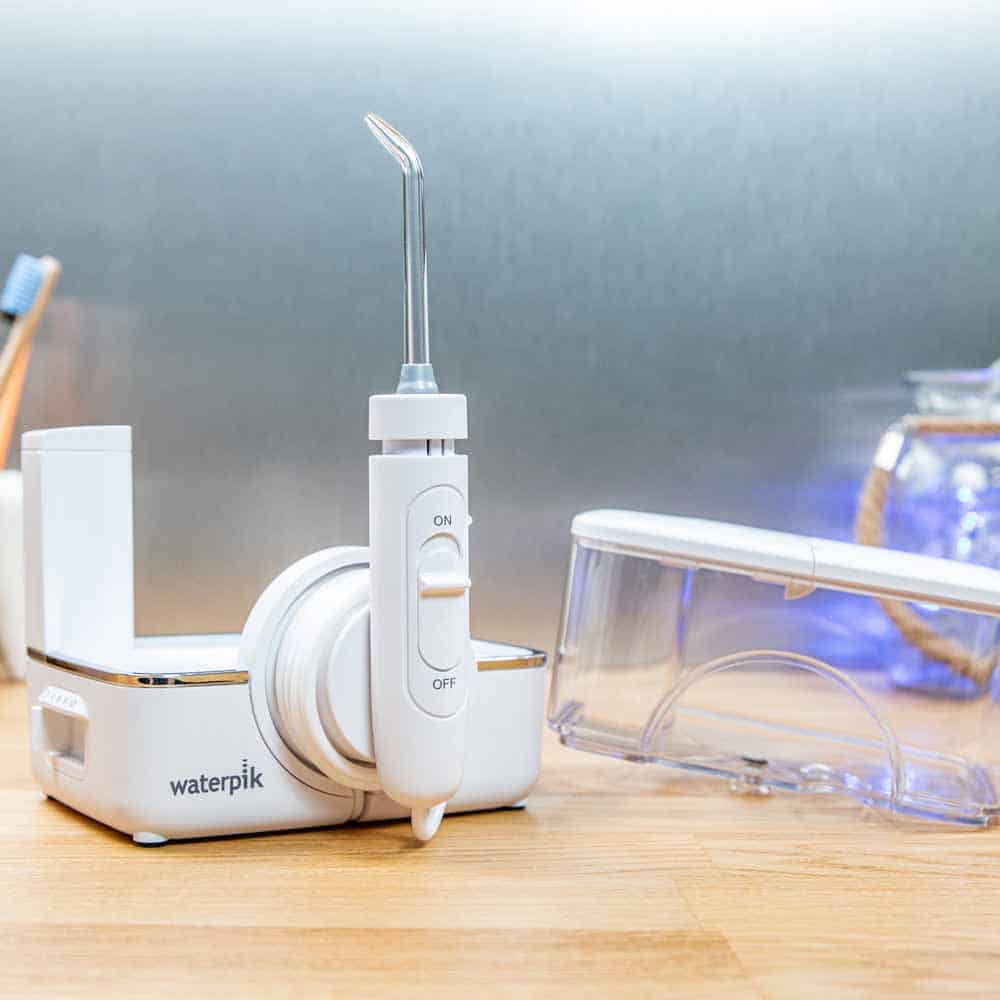
Although the design differs slightly for the most part they are identical. The FAQ section lists out the key differences, but I will call them out too as I talk through the use of the unit.
There are essentially 3 key parts to the flosser. You have the water tank/reservoir, the main unit, in which the pump and battery sit and then the handle.
With both variants the reservoir is removable. This makes it easy and more convenient for filling up with water.
The water tank is made from clear plastic, so you can see the water inside easily. This sits on top of the main unit.
In the bottom of the tank is a sprung loaded plug that releases as it sits on the unit. This allows the water to flow into the pump. When the tank is lifted off, the plug forms a seal in the base to prevent water from leaking out.
On the top of the water tank is a lid. This covers the whole tank, but is hinged in the middle so that you can access the water inside and refill with more ease. The whole lid can be removed if you like. It does only fit on one way though, lifting from the right side and hinging on the left.
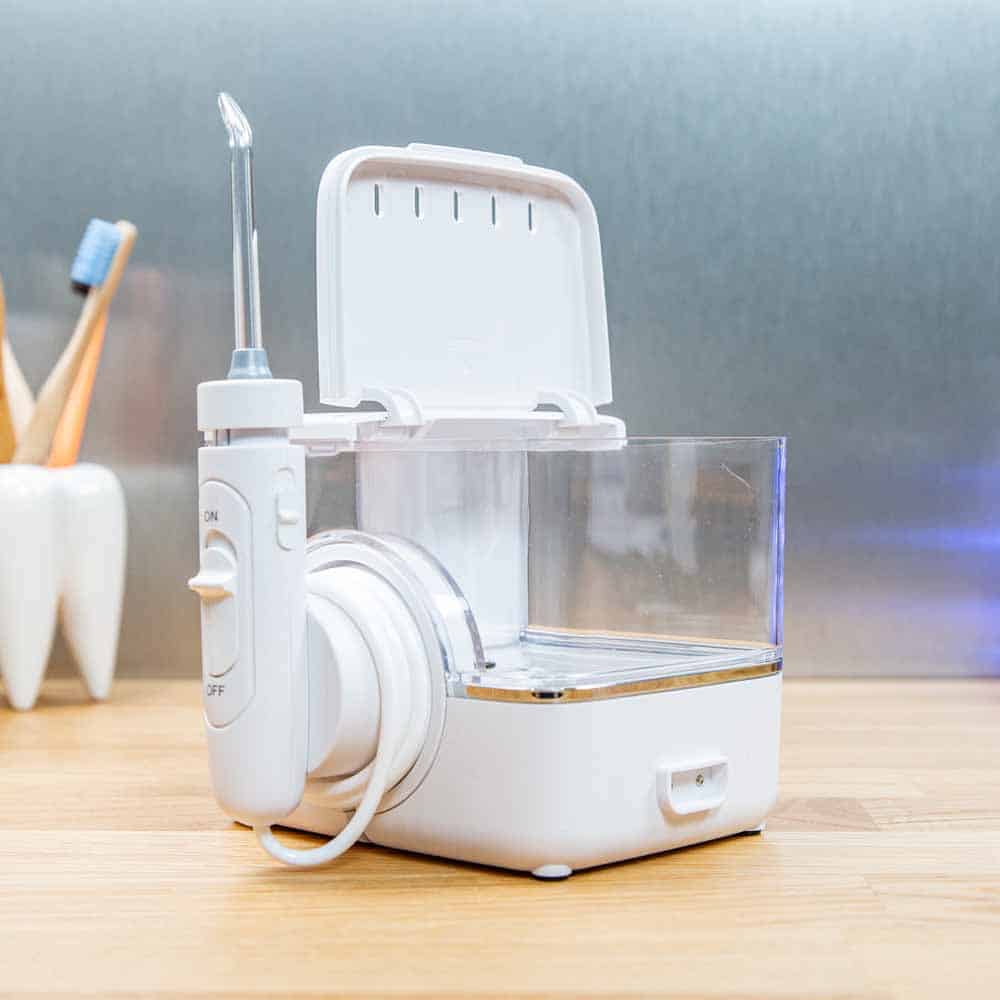
The tank sits around what can best be described as a column that extends up from the base unit. The position is different on the ION and ION Professional. The ION has it in the middle at the back of the unit, whilst it is in the back left corner of the Professional.
On the top of the column is the power button for this unit.
Inside the base unit is all the technology necessary to make the unit function. The Professional variant has a slightly smaller footprint overall.
On the right side of the unit is a moulding with 2 pins in. This is the power cable connection point. The cable magnetizes to the base unit and makes fitting very simple.
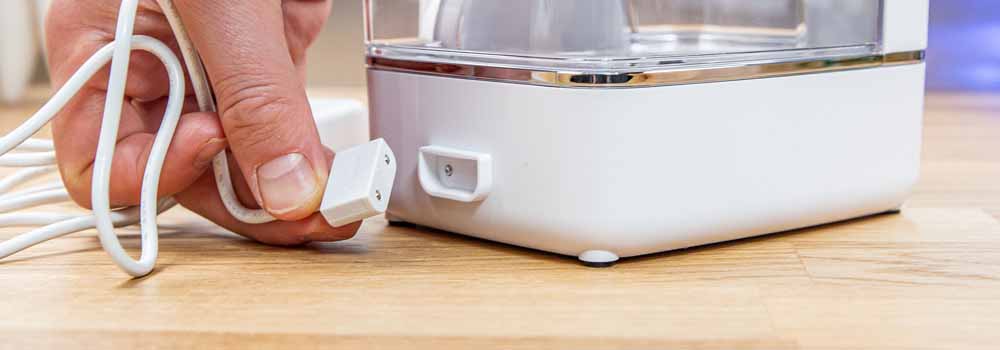
There are no controls on the back of the unit.
On the left side are the controls for the variable pressure settings. This is where the ION and Professional differ more significantly.
With the ION, there is a round rotating control dial protruding from the base unit. The Professional on the other hand has a much smaller sliding switch that sticks out by just a few millimetres.
The Professional looks cleaner and more minimal in its appearance. However, it is the rotating dial on the ION Cordless that is arguably more practical. It is easier to see at a glance which pressure setting has been chosen. It is also easier in my opinion to change this pressure during any flossing session.
The Professional’s pressure settings are not difficult to change, but the position is a little more awkward in that to ensure you slide the dial to the right place, it just feels like you need to give it a bit more attention.
On the base of the units are 4 rubber feet that help prevent it from slipping on a countertop.
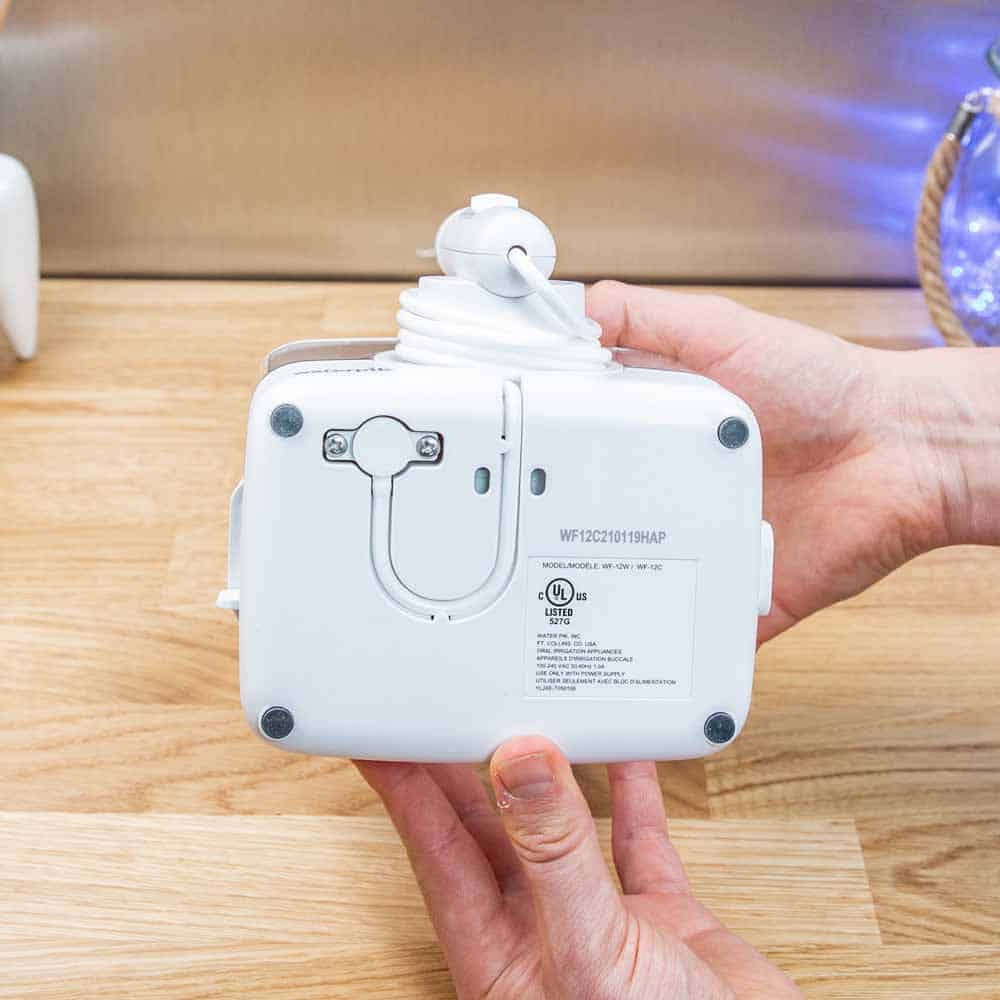
Looking at the front of the unit, you are presented with the handle.
This sits a little proud due to a moulding around which the hose wraps.
The handle is magnetically attached to the main base unit and is easily removed each time you need to use it. Such a configuration also makes it really simple to place the handle back.
The hose is colour matched to the unit and gives you about 3 ft/90 cm of length from the base unit itself.
Attaching to the top of the handle is the nozzle/tip through which the water is pushed out into the mouth.
The handle has a cylindrical shape and tapers down at the bottom where the hose connects. The handle actually rotates a full 360 degrees around the hose, which improves movement and reduces tangle.
On the front of the handle is a lege and easy to use on/off slider switch. This controls the water flow. You do need to press the power button on the base unit before and after each use.
Although the slider switch is easier to use, the handle is smaller than most other countertop units handles. This means it is fractionally more awkward in hand and you need to position your grip lower down the handle to retain control of the slider. It isn’t terrible it just doesn’t feel quite as natural. This is a compromise for an overall more compact unit.
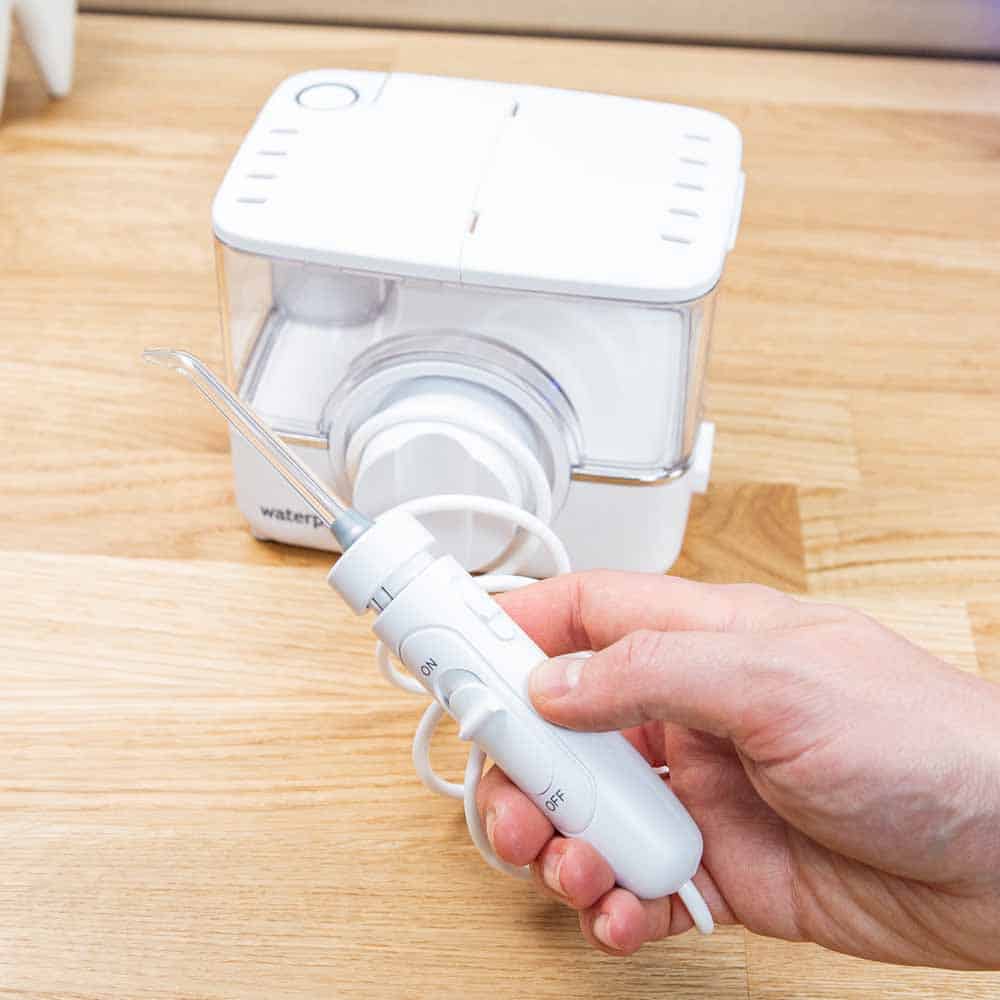
On the right side is another small slider switch, this is the release for the nozzle/tip. Slide it up to release the nozzle when you want to change it.
The part of the handle the tip clips into can be rotated a full 360 degrees. This is a handy and common feature on many water flossers. It helps you position and directs the water more accurately when in use.
I don’t need to rotate the nozzle a lot, but it is certainly nice to have this option. It makes things a little more convenient and the product overall a bit more versatile.
It works on the ION, but disappointingly it isn’t quite as easy to use as models like the Aquarius.
There is no texture or ridges around the rotating element, thus giving less tactical surface area to grip onto and aid with the rotation. The current configuration looks cleaner but marginally less practical. I personally prefer practicality over design.
Included in the box with the Professional are no less than 7 tips. 6 of these are different styled tips.
- 2 x JT-100E classic jet tip
- 1 x DT-100E implant denture tip
- 1 x OD-100E orthodontic tip
- 1 x PP-100E pik pocket tip
- 1 x PS-100E plaque seeker tip
- 1 x TC-100E tongue cleaner
The only other tip not included is the:
- TB-100E Waterpik Water Flosser Toothbrush Tip
The WF-11 ION does not come with the tongue cleaner tip included.
For most the classic jet tip is most suitable, but as the names imply some are specially designed for specific scenarios that might apply to you.
Whether you have braces, dental implants, dentures, or a crown there is an appropriate tip for you. You can find more information on each of the different tips here.
Any of the tips can be purchased separately.
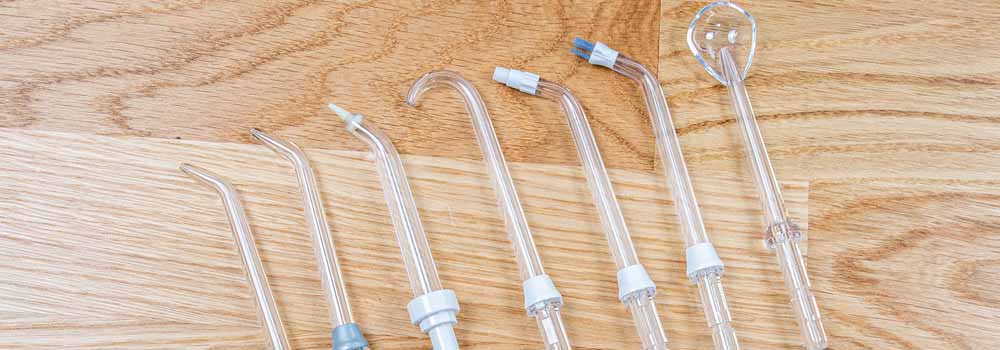
I do like that out of the box you have a variety of options, it makes it easy for any user to get up and going immediately. But it is somewhat of a waste.
For myself, for example, I am typically only going to use the classic jet tips, thus I have 5 tips I will never use. What will I do with them? I guess they will have to go in the bin.
Tips should be replaced regularly. Every 6 months for the classic jet tips, every 3 months for the Orthodontic and pik pocket, amongst others.
You do get a storage case included to put spare or additional tips within. This is a simple and nice touch.
It is amazing just how much debris the ION water flosser blasts out from between the teeth. I could feel and physically see food particles being removed. I have been impressed with the results.
I mentioned the 10 pressure settings. It is important you find the one right for you. I personally find about 6 or 7 to be ideal. 10 is very powerful.
The pressure ranges from just 10 PSI at level 1 through to 100 PSI at level 10.
Using the pressure dial or slider you can change the setting as often as you like and it changes immediately.
Despite my preference for a more powerful setting, my mouth did feel clean after use with more gentle modes.
The lower pressure setting is good for new users and those who might be recovering from surgery or some other form of dental treatment.
How much flossing time you get depends on the model and the pressure setting chosen.
From the ION Professional, I got 1 minute and 50 seconds (110 seconds) of usage when set to the highest setting and a staggering 5 minutes and 40 seconds (340 seconds) on the lowest setting.
This is actually longer than you get on models like the Aquarius which have larger reservoirs. I am not sure exactly why. The flow rate per minute is the same.
The only other notable difference is the pulses per minute in the water flow. You get 1400 with the Aquarius compared to 1300 with the ION.
A small feature not offered on all countertop units is a timer/pacer. You get this with the ION.
30 and 60 seconds after switching the unit on, there is a brief pause in the water flow. It also changes the sound of the unit. This is your cue to move from 1 section of the mouth to another.
Whilst you can floss for as long or as short as you like, the idea at least is to spend 30 seconds cleaning the lower arch of teeth and 30 seconds cleaning the upper arch. Thus, in 60 seconds your water flossing is complete.
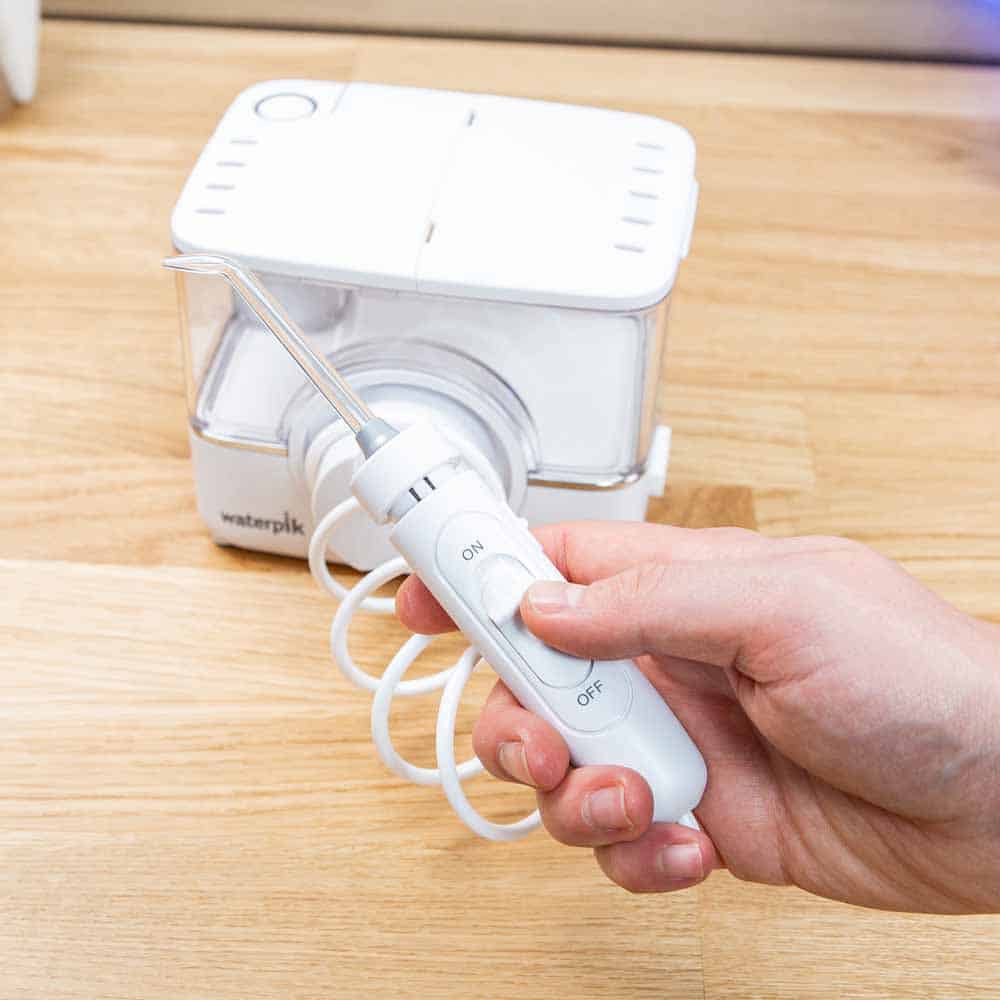
Once you have mastered the technique you can probably achieve a full floss in about 45 seconds, but 60 is that nice target time. It is long enough you get a thorough clean that you are not rushing, but not so long you feel like the process takes ages.
Stick to this 60 seconds and you are on track for achieving the 28 days of flossing time from the battery.
You should also find that you can get about 2 sessions from a full reservoir too.
The pacer stops after 1 minute. So for example, if you are still flossing at 90 seconds you don’t get a third pause.
The ION will actually automatically turn itself off after 3 minutes of continuous use. You can press the power button again and start it off. Although Waterpik does advise not to use the unit for anything more than 5 minutes in any 2 hour period, not that most would need to.
When in use, it is not silent, it produces a sound up to approx 79 decibels. This is quite loud. You would want to shut the bathroom door or potentially avoid using it if you had someone sleeping in the room next door.
Lukewarm water is advised when using this. You can use cold, but it feels much harsher on the gums. For those wanting extra freshness as they clean, you could add a couple of dashes of mouthwash to the water.
Over the last few years, Waterpik appears to have been making small tweaks and improvements to their products and that has resulted in a more comprehensive range but also better quality products.
The overall build quality is good and as I suspected and hoped for at this price. It is definitely comparable to the likes of the Aquarius. And arguably a bit better. It certainly looks a bit fresher and minimal.
Having been made by a leading brand, one hopes for long term reliability. Electronic products like this are more susceptible to breaking but added peace of mind comes from the 3 year warranty Waterpik offers.
Summary of design, usability, clean & general use
- Cross between a cordless & countertop unit
- Built-in rechargeable battery so it can be used a bit like a cordless
- Large water tank & more features found on a countertop model
- Available in 2 colour options
- 20 ounce water tank
- 10 pressure settings
- 340 seconds of usage time on the low mode
- 110 seconds of usage time on the high mode
- Good cleaning results - backed by clinical evidence
- American Dental Assosciation approved
- 7 tips included
- Rotating handle & nozzle
- Built-in timer & pacer
Battery life
Both the WF-11 and WF-12 have a rechargeable Lithium-Ion battery built into the water flosser. This means they can be used without being connected to a power outlet.
With both, the claimed running time is 28 minutes. Or to put it another way, 28 days, based on being used once a day for 1 minute at a time.
Waterpik themselves are not explicit as to whether this running time is based on the lowest or most intense power setting, or perhaps somewhere in between.
Naturally, I put it to the test.
I achieved 30 minutes of use from a full charge. This is based on using the flosser set to the highest pressure setting, 10.
That is equivalent then to 30 days of use, each for 1 minute at a time.
This exceeds the claimed life by 2 minutes or 2 days.
I think this is perfectly acceptable.
Although the unit has a rechargeable battery inside, you can still use it whilst connected to a power socket. In fact, you can even disconnect the power mid-session and it continues to function.
A full charge takes somewhere in the region of 4.5-5 hours.
The flosser has an LED ring around the power button. This is lit with a blue light to give feedback on the battery status.
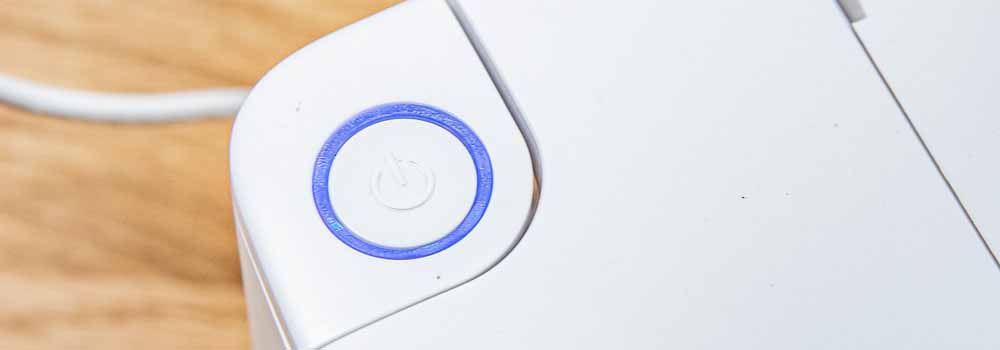
When connected to the power and charging, the blue light will pulse slowly.
When the battery is recharged, but still connected to power, the light ring will emit a quick flash of the light every 3 seconds.
In use, once the battery in the flosser is becoming low and in need of a recharge, the light ring will be lit with a blue light and flash/blink 3 times. This will happen when the battery is down to about 30%. You should therefore have a few days left before it really will need to be charged.
By no means a deal breaker, it would be nice if the light emitted from around the button was perhaps green when it was fully charged, amber when there is a moderate charge and red when it was low. These colours would give a little more visual feedback to us as users.
Included in the box is a 2 part power cable. I like this configuration.
The cable that connects to the ION is actually magnetic. It aligns with 2 pins on the right side of the unit. Magnets snap and hold it in place when they are within a few millimetres of each other. It makes it super easy to actually attach the cable.
This setup does also mean it is a little safer if the power cable should ever get snagged or pulled because it will just detach from the unit.
At the other end of this magnetic cable is a male USB Type-A connector. This can be plugged into a USB port on a computer, wall socket, power bank, etc.
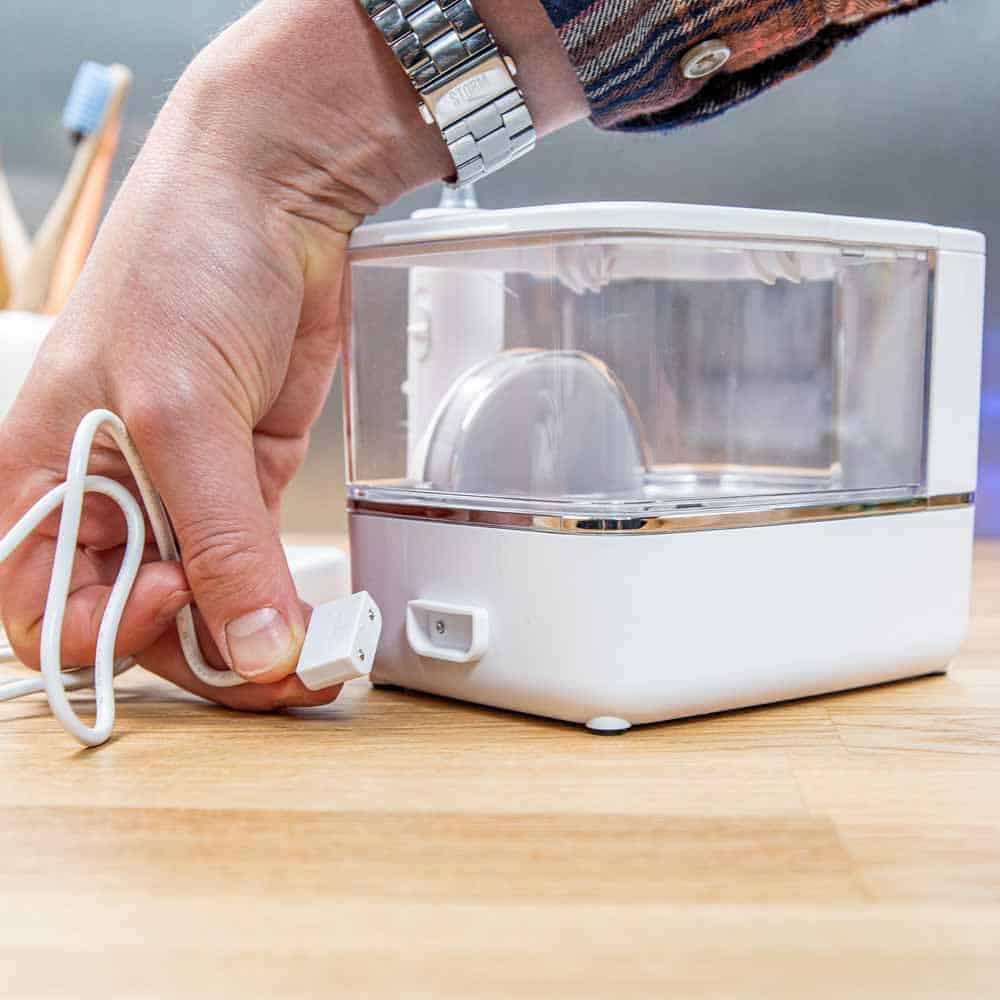
Or of course, it can go into a USB power adapter like the one provided.
The 2 pin US power brick has a female USB Type-A port on it.
The cables and power adapters are either black or white, colour matched to the unit you have.
The USB power brick supports 100-240v, making it a little more convenient for international travel. All you might need is a plug adapter. Or alternatively, you can connect the USB cable to a USB power brick specific to the country in which you are travelling to.
Summary of battery life
- Built-in rechargeable Lithium-Ion battery
- Claimed battery life of 28 days/28 minutes
- Achieved 30 days/30 minutes
- Takes up to 5 hours to charge
- Can be used whilst connected to the power outlet
- Comes with a magnetic USB cable
- 2 pin USB power brick supplied
- Supports 100-240v
- Pulsing blue light means it is charging
- A quick single flash of the blue light every 3 seconds means it is charged
- 3 flashes of the blue light mean the battery is low & requires charging
Price & where to buy
I have included links to buying options here at the start of the review.
In the section below, I discuss the price more generally and in relation to similar products.
The retail price of the ION Professional is CDN $132.84.
From experience, I know that this is at the higher end of the price scale for a cordless water flosser.
At the lower end I know you can purchase a Waterpik model for less than CDN$55 and if you go for a lesser known brand then the price can even be under CDN$40.
Price and what something is worth are inevitably subjective.
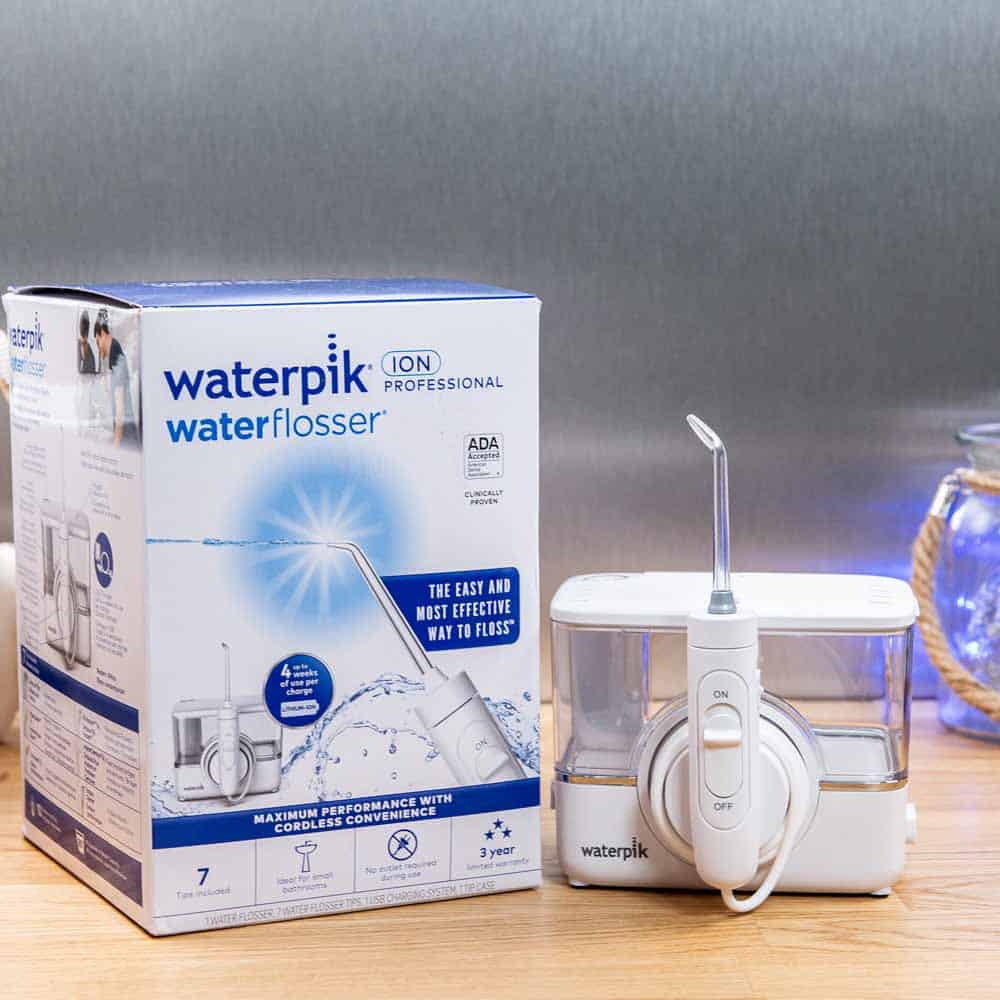
Given the features the ION has and the fact that it is a little different from most other products, I would argue it does command a little bit of a premium. And that is without mentioning it is made by the market leading brand.
Don’t go expecting a discount. A few dollars at best is what you will get.
Prices do vary from one retailer to another and of course, are always subject to change.
Although it comes with multiple tips included, you will need to replace them.
As a general rule expect to pay CDN$12 for a pack of 2, making each tip $6.
The classic jet tips require replacement every 6 months, whereas some of the other tips require replacement every 3 months.
Of course, using the more specialized tips will impact the long term ownership costs.
Here at Electric Teeth, we like to price a unit over 3 years, to give a benchmark of costs.
On top of the initial purchase price, you will be looking at an additional 4 nozzles, at a cost of CDN $24.
This makes the total cost CDN$159 (rounded) for the ION Professional.
This excludes the cost of water, electricity, etc but it gives you a good idea.
For the sake of comparison, the corded countertop unit, the Aquarius costs CDN$108, whilst the Cordless Advanced costs CDN$119.
Unless you need the specific benefits this brings, the Aquarius is better value and the Cordless Advanced more portable.
You can potentially extend the value you get from this by sharing it with other people in your household. You will need to change the nozzles each time, but it is one way of lowering the total cost.
Please note that all prices quoted are approximates and will vary based on location, supplier and time of purchase. These figures were correct at the time of writing and should not be relied upon as hard fact, but used as a guide during your decision process.
Summary of price & where to buy
- List of buying options included here
- Recommended retail price of CDN$132.86 for the Professional
- No real discount
- Replacement tips cost CDN$12 for a pack of 2 - $6 each
- Cost over about 3 years is $159
- Waterpik Aquarius is cheaper
Reliability & long term use
Only long term daily use will really show just how reliable or not a product is.
Unfortunately, I am somewhat limited in how long I can test each individual unit.
As it stands I have little in the way of concern for the reliability of the ION and ION Professional. During my testing, everything has worked as expected.
I will be sure to highlight any reliability issues if I or other readers discover them at a later date.
Waterpik does appear to have been taking steps to improve overall reliability and build quality in their products in recent years. Adding quite a bit of peace of mind is the fact that the ION comes with a 3 year/36 month warranty. Many other similar products come with just 12 months/1 year.
Conclusion
The ION is a great water flosser.
Truthfully like many of Waterpiks products of late, there isn’t a great deal to complain about. What criticisms there are, are in fact relatively small in the scheme of things.
I really do like that this boasts the benefit of countertop and cordless. A large water tank with a rechargeable battery. For some people, this is a real benefit. The biggest winners are those who want a countertop unit but don’t have a power outlet in the bathroom or the location they want to use it.
The nozzle is a little more difficult to rotate and the handle a built smaller in hand than other options. These are 2 compromises for a more compact unit.
If you are confused and not sure what you want, check out these options.
Size guide
- Water Flosser Height With Nozzle - 18.5cm / 7.3 inches
- Width - 15cm / 5.9 inches
- Depth/thickness - 14.5cm / 5.7 inches
- Weight with nozzle (no water) - 603g / 20.8oz
- Package weight - 1070g / 37.8oz
Noise
- 80dB
Country of manufacture
- China
FAQ
What's the difference between the ION and ION Professional?
- Reservoir
- The standard ION has a 22 ounce capacity compared to the 20 of the ION Professional.
- Flossing tips
- The ION comes with 6 flosser tips compared to the 7 of the ION Professional.
- The professional comes with the tongue cleaner tip that the ION does not.
- The ION comes with 6 flosser tips compared to the 7 of the ION Professional.
- Size & weight
- The ION measures 7.6 inches tall compared to the 7.3 inches of the Professional.
- The ION measures 6.2 inches wide compared to the 5.9 of the Professional.
- The ION measures 6.1 inches deep compared to the 5.7 of the Professional.
- The ION Professional weighs 1.33 lbs compared to the 1.3 of the ION.
- Design
- The ION Professional has a squarer design compared to the more rounded shape of the standard ION.
- The pressure dial on the ION is a rotating wheel that extends from the left side compared to the lower profile slider on the Professional.
- Price
- The ION has a retail price of $89.99 compared to the $99.99 of the ION Professional.

